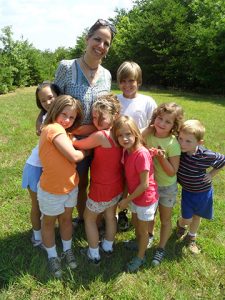 I became an Integral Yoga Teacher in the spring of 2005. For whatever reason, I immediately knew I wanted to specialize in teaching children’s Yoga even though I had no prior experience working with children. Those early classes were an education in themselves as the kids ran around the room and seemed uncontainable! One day I had an inspiration: “What if I sang the class?” Right then and there I plopped down on the floor and began scripting songs for poses, later developing story adventures all designed to capture their attentions and imaginations as we stretched and breathed into our Hatha Yoga. The songs are also a great way to hold them in an asana longer.
I became an Integral Yoga Teacher in the spring of 2005. For whatever reason, I immediately knew I wanted to specialize in teaching children’s Yoga even though I had no prior experience working with children. Those early classes were an education in themselves as the kids ran around the room and seemed uncontainable! One day I had an inspiration: “What if I sang the class?” Right then and there I plopped down on the floor and began scripting songs for poses, later developing story adventures all designed to capture their attentions and imaginations as we stretched and breathed into our Hatha Yoga. The songs are also a great way to hold them in an asana longer.
The characters I developed over the years have become as real to my students as they are to me. Farmers Brown’s organic, vegetarian, sustainable farm is a utopia unto itself; many of his animals—Old Brown Cow, French Fry, and Sunshine his horses, the Swampy Swamp where the frogs are hopping, the river that changes with the seasons, and the ever mischievous Slinky the Fox who chases after the Rabbits and Chickens—are beloved friends. Sri Swami Satchidananda appears in class as the “man with the long white beard” who guides the children in meditation. I often have him sitting with his eyes closed in a grass hut. As he sees us enter, he guides us into our meditation, and then when we open our eyes he has transformed into a lion, or a rabbit, or a monkey. In keeping with Gurudev’s vision, I also incorporate how we can be stewards of our natural world, compassionate to others, and healthy in our eating choices.
I have been a full time kid’s Yoga instructor for ten years now, and am teaching hundreds of children in a given week at daycares, schools, gyms, and studios. To ensure I reach as many kids as possible, I have begun training more “Yoga with Nitya” teachers and there are six of us now in Richmond, Virginia, and I hope to expand further.
To advance this quest, I produced my first “Yoga with Nitya” DVD in 2012 and then in 2014, published my book, A Child’s Journey into Yoga, which is the first children’s book to illuminate some of the core sutras of Patanjali. The book is a story about a young girl who learns to grow up living Yoga and the narrator is “the man with the long white beard,” our beloved Gurudev. Without giving too much away, the journey ends at Yogaville.
While I never met Sri Swami Satchidananda, he is someone about whom I reflect, especially when I visit Yogaville. Something about him touches me so deeply, like no other teacher or guru. I have felt his presence every time I teach or lead kirtan, and I truly believe I am living out his mission of sharing Yoga with children as a means of creating a more peaceful and compassionate world. Seeing a room full of children in meditation, or engaged in a pose, and singing along with me is fulfilling that mission—those moments are my ultimate achievement. Whenever I feel weary or stuck or fall into self-doubt, I feel Gurudev smiling behind me and I know I am doing exactly what I was put on this earth to do. Yogaville is my spiritual home and, every time I return there, I breathe in his breath, I walk with his feet, and his love fills my entire being until I imagine I could fly on my bliss. What a tremendous gift he is to all of us. Jai Gurudev!
Try This!
A Child’s Journey into Yoga offers a story filled with wisdom and experiential activities to foster the concept of living Yoga while instilling some of the core sutras of Patanjali. How you bring these ancient sutras into the classroom for elementary school-aged children is a fun and innovative challenge. Here are some examples:
- Teaching non-greed or aparigraha: Use a piñata filled with coins and take the opportunity to discuss not only greed but why some people wind up with so much and others wind up with so little and tie it into world or local economies.
- “Yogas chitta vritti nirodha”: Fill a glass bowl with water, add soil, and let it settle to the bottom. This represents your natural mind and it is pure, clear, and calm—like when you first wake up. The mud is all the stuff that comes up in your day that can be disturbing and cause negative emotions. Ask the children to give examples of what makes them mad, for example, and stir up the water so the mud makes it cloudy. The students can now see how when our mind is disturbed thinking clearly is harder to do and we are more likely to make mistakes or react badly.
- Finding the truth through direct perception, inference, and learning from a reliable source: Have students sit in a circle and play Gossip Train or Telephone. One student whispers something ridiculous to the person next to them and they then whisper what they heard to the next person, going around the circle until everyone has heard it. I guarantee the last person will not have heard what was originally said. This is a fun way to emphasize the importance of getting information from a reliable source.
- Practice becomes firmly grounded when attended to for a long time, without break, and with enthusiasm. Give the students “Om Work” of writing in journals every day about their practice. They can choose to do three or four of their favorite asanas. They should record what they experienced physically, emotionally, and even spiritually in each of the asanas, as they are held for a minute or longer. At the end of the week have a sharing circle to discuss how this level of focus enhanced the benefits of their practice.
- The Four Keys: Teach children various ways they can utilize the four keys (friendliness, compassion, delight, and disregard) to unlock the doors of challenging situations. For example:
Fisher was enjoying upsetting Mica and was ready for her this day. Mica had made friends with Isaiah, after their time together on a science project, and she looked out for him. At lunch, as Isaiah unwrapped his sandwich, Fisher rolled a rotten apple full force right down the center of the table. He laughed wickedly as the apple hit Isaiah’s thermos, spilling its contents and shooting rotten apple bits all over his lunch. Isaiah sat stunned with his mouth open wide. Mica held her anger in check. She caught herself by taking a really deep breath and exhaling out all the anger in her body. She remembered: “Disregard is the key to the door of the wicked.” Fisher was watching her, expecting her to blow up like she had before. She caught Fisher’s eye as she continued to take deep breaths, then she calmly walked over to the lunchroom supervisor, and told her what had just happened. Fisher was sent home early with a detention and Isaiah got a free slice of pizza. Mica sat down with a sigh and said to herself, “That felt so much better than getting angry.”
About the Author:
 Nitya Griffith has been a certified Integral Yoga® teacher since 2005 and her biggest passion is teaching children of all ages. Nitya is an E-RYT200 with a CRYT and she is registered with Yoga Alliance. She launched her national brand, “Yoga with Nitya,” with the release of her kid’s Yoga DVD. This DVD and her book, A Child’s Journey into Yoga, are available from Amazon.com. For more information, please visit: www.yogawithnitya.com.
Nitya Griffith has been a certified Integral Yoga® teacher since 2005 and her biggest passion is teaching children of all ages. Nitya is an E-RYT200 with a CRYT and she is registered with Yoga Alliance. She launched her national brand, “Yoga with Nitya,” with the release of her kid’s Yoga DVD. This DVD and her book, A Child’s Journey into Yoga, are available from Amazon.com. For more information, please visit: www.yogawithnitya.com.


